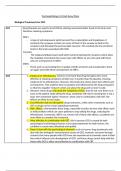Psychopathology 16 Mark Essay Plans
Biological Treatments for OCD
AO1 Drug therapies are used to treat OCD by altering neurotransmitter levels in the brain and
therefore reducing symptoms.
SSRI’s
- A type of anti-depressant which prevent the re-absorption and breakdown of
serotonin the synapses so there are more of them in the synapse to bind to the
receptors and stimulate the post-synaptic neurone. This combats the low serotonin
levels in the brain associated with OCD.
Tricyclics
- The original antidepressant used which work by blocking the receptors which allow
the reuptake of serotonin but cause more side effects so are only used with those
who are unresponsive to SSRI’s.
SNRI’s
- These work on preventing the re-uptake of both serotonin and noradrenalin, these
are again used with those unresponsive to SSRI’s.
AO3 1. Evidence for effectiveness, Soomro et al found that drug therapies were more
effective at reducing symptoms of OCD over 3 months than the placebo, showing
evidence for its effectiveness. However, this study only shows short-term effects and
not long term. This could be done on purpose and influenced by the drug companies
so that less negative research comes out about the drug and so more is sold.
2. However, these drugs only mask the symptoms of OCD, they do not cure them so as
soon as the patient stops taking the drug, symptoms will return meaning this is not a
long- term treatment option. However, when used in combination with CBT, the
effects are likely to last longer.
3. Cost effective and non-disruptive- drug treatments, unlike other treatments such as
CBT so drugs can be a more appealing treatment.
4. Side- effects, unfortunately these drugs, especially tricyclics do have side effects such
as hallucinations which can cause patients to stop taking the drugs, reducing the
effectiveness. Conversely, SSRI’s run a lesser risk of these side effects, so patients are
more likely to complete the treatment.
5. Most effective in combination with CBT, this is because OCD is caused by both
psychological and biological factors so by using treatments for both factors, the
condition is cured more effectively and quickly.
6. Doesn’t deal with the psychological elements such as trauma, drug treatments only
deal with the biological/ neurochemical causes of OCD, however, we know through
research that many people with OCD have also experienced a traumatic event in their
lives which influence the development of OCD, and these drugs cannot help with this.
Hence why OCD is often most effective in combination with CBT.
, The Biological Approach to Explaining OCD
AO1 OCD is an anxiety disorder comprised of two elements, obsessions and compulsions.
Genetic Explanations:
- OCD is said to have a genetic basis due to the high concordance rates in families. However,
due to recent research into the diathesis- stress model, it has been found that genetics
present a vulnerability to OCD rather than a certainty and other environmental factors can
trigger the condition.
- There are certain candidate genes which are known to create vulnerability, for example, SERT
which has been shown to lower serotonin levels in the synapses and COMT which lowers
dopamine levels in the brain.
- OCD is polygenetic meaning it is not caused by one gene, in fact there are 230 genes which
can create a vulnerability for OCD although most of these genes have roles in altering levels
of the neurotransmitters which regulate mood.
- Different types of OCD may also be a result of different genetic variations such as hoarding
disorder.
Neural Explanations:
- Low levels of serotonin have been associated with OCD as it affects the transmission of mood
related information between neurones, meaning mood is affected.
- Abnormal functioning of the frontal lobes has also been associated with OCD. The frontal
lobes are responsible decision making and logical thinking, so if this is impaired, this can lead
to obsessions.
- Abnormal functioning of the hippocampal gyrus is also associated with OCD, this area is
responsible for processing unpleasant emotions so abnormal functioning can lead to
heightened anxiety.
AO3 1. Real life application into the development of treatments such as SSRI’s which increase
serotonin levels in the synapses. The fact that these are effective in reducing symptoms of
OCD shows that serotonin has a role in OCD.
2. There is good supporting evidence of genetics due to twin studies by Nastadt et al who found
higher concordance rates of OCD in MZ twins than DZ twins. However, as concordance rates
are never 100%, this shows that other factors must have some influence. Furthermore, this
evidence is flawed as we cannot separate biological and environmental factors so we cannot
determine that biology caused the higher concordance rates.
3. OCD being polygenetic is a limitation as this means it has limited application into treatment
options as we cannot pinpoint specific genes, so it has little predictive value.
4. This approach is biologically reductionist as it only takes into account biological factors and
not environmental factors which could trigger the onset of OCD. Furthermore, research has
shown that many people diagnosed with OCD have also experiences a traumatic event in
their life. Showing the disorder is not entirely genetic in origin and it would be more
productive to focus on environmental factors as these can be used in treatment. This shows
that the diathesis-stress model may be a better explanation to the disorder.
5. We cannot determine cause and effect when it comes to neural mechanisms in OCD as it is
simply a correlation. This means that OCD could cause abnormally low serotonin and
dopamine levels instead of the other way around.




